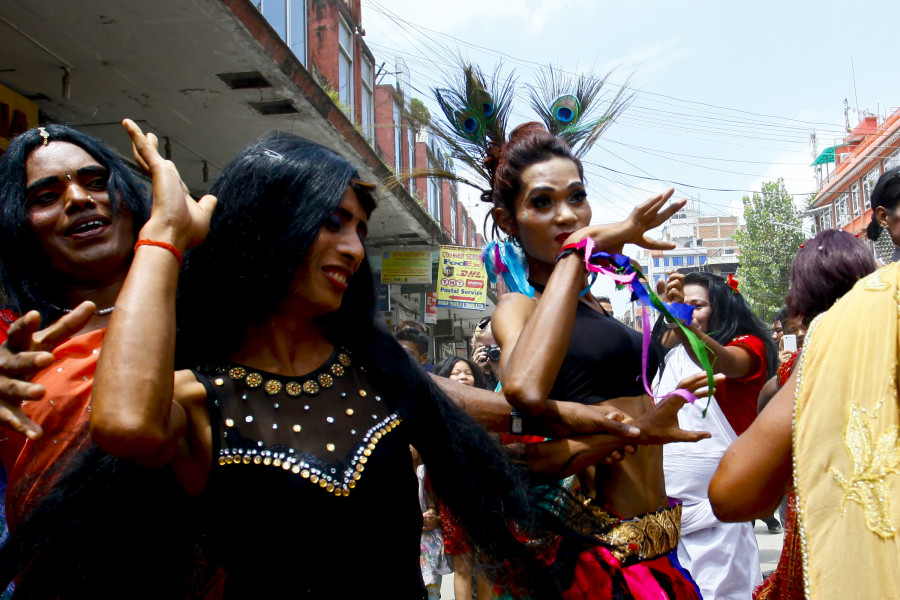Life & Style
Marking pride month, Nepal’s first pride parade to take place tomorrow
While pride marches have taken place since 2002, the parade hopes to amplify advocacy around the entire queer identity spectrum.
Asmita Manandhar
Down the alley behind the Krishna Mandir in Patan, inside a small room, rectangular cardboard signs are stacked neatly beside tiny rainbow flags.
Members of the Queer Youth Group are busy preparing placards for Nepal’s first pride parade, to be organised on Saturday, marking Pride Month.
Since 2002, Nepal has celebrated its own pride march on Gaijatra—a Newar festival that takes place every August. This annual pride march, organised by Blue Diamond Society, Nepal’s first LGBTIQ advocacy organisation, attracts attendees from around the country.
But younger members of Kathmandu’s queer community are attempting to move away from the pride march’s association with Gaijatra in order to amplify advocacy around the entire community.
“Gaijatra is a huge cultural event. There are so many things going on during the festival that the queer agenda gets diluted,” said Rukshana Kapali, a member of Queer Youth Group. “We are even sidelined in mainstream media.”
Gaijatra is an occasion to commemorate the death of a family member during the past year. A flamboyant festival, family members dress up as cows or various Hindu deities, usually in exaggerated make-up and costumes, and parade the streets of Kathmandu.
Because of the irreverent nature of revelry associated with the festival, many groups also see Gaijatra as an occasion to question social bigotry.
“The festival is about humour and mockery, so many seniors have built the perception that the pride march is also a form of exaggeration—or, simply put, guys dressed in women’s clothing,” said Kapali. “If we are to challenge social perceptions about the queer community, taking to the streets should mean we are standing for equal rights and visibility.”
According to Pinkey Gurung, chairperson of Blue Diamond Society, the Gaijatra pride march started as a means to commemorate people from the LGBTIQ community who had lost their lives to AIDS.
“The concept of pride month is a foreign one that originally comes from the US. So, organising a pride march during Gaijatra is also about owning the queer issue in a culturally accepted setting,” said Gurung.
Sunil Babu Pant, Blue Diamond Society’s founder, through his 2017 piece published by Medium, had explained his rationale behind organising a pride march during Gaijatra as going beyond “safety and mainstreaming”. As both ‘pride’ and ‘march’ have negative connotations in the Nepali language, organising a separate parade was “not only unnecessary but can become counterproductive too, if it becomes too much on the face,” he had said.
Blue Diamond Society is credited for bringing LGBTIQ rights to the political forefront. It was the primary plaintiff in the public interest litigation case registered against the Nepal government, which led the Supreme Court of Nepal to recognise transgender individuals as “third gender”.
While the queer community has hailed the Supreme Court as a landmark victory, many younger members believe that the state is using that same verdict to box all queer people into the ‘third gender’ category, refusing to acknowledge identity and orientation on a spectrum.
“The queer discourse in Nepal is evolving, which is natural for every movement. Sharing diverse experience and perceptions are how any movement can grow,” said Subha Kayastha, a member of the Queer Rights Collective, a safe space coalition of people from across the gender and sexual spectrum working with Queer Youth Group to organise Saturday’s pride parade.
Queer Youth Group is also attempting to move away from the term LGBTIQ, a popular acronym to describe the queer community collectively, as they believe a new term is needed to be more inclusive of the diverse queer spectrum. Rather, they’ve adopted another acronym: MOGAI (pronounced ‘muggy’) as an umbrella term, which stands for marginalised orientation (sexual/romantic), gender alignment (identity/expressions), and intersex bodily variation.
Kayastha believes in the need for more pride parades, disagreeing with Pant, who stated in his article that multiple pride parades could be counterproductive. “The more parades we have supporting the queer community, the more the issue stays visible and increases solidarity within the queer community,” she said.
Meghna Lama, who runs Pink Tiffany, Kathmandu’s first openly LGBTIQ-friendly restaurant, agrees with Kayastha. “Organising a pride parade during pride month will help Nepal’s queer issues be highlighted internationally,” she said.
But, unlike Lama, Gurung will not attend Saturday’s pride parade. “The event hasn’t been discussed with us, so we aren’t sure of their plans. I will probably be out of the Valley,” she says.
Preparations are complete, say, organisers, with the Facebook event page listing more than 800 people as interested or attending. But organisers are aware that such numbers are not always accurate.
“We don't mind if it's a small number,” said Kapali. “We just want to bring forth an inclusive narrative within the queer community and beyond.”
The pride parade will take place on June 29, Saturday at 10am from Maitighar Mandala to New Baneshwor.




 7.12°C Kathmandu
7.12°C Kathmandu.jpg)










